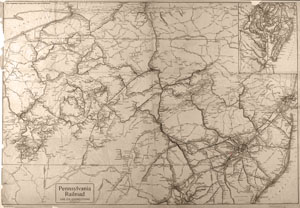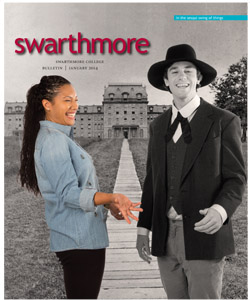Train remains a selling point

A portion of the sprawling Pennsylvania Railroad network in 1911, showing Swarthmore (red star), the Philadelphia region, and connections to New Jersey and New York City.
While historically important, the train, whose ka-klunk and whistle are heard from every point in Swarthmore, is a lifeline for the College and community. It’s essential not only to students (first years can’t bring cars to campus) but anyone with a hankering for world-class art museums, concerts, or “Philly-style health food—cheese steak, hoagies, and grinders,” as Jim Bock ’90, vice president and dean of admissions, puts it. It’s also essential to the College workforce.
Tania Johnson, associate director of sponsored programs and institutional relations, has a half-hour daily commute to Swarthmore from Aldan, Pa. She’s never owned a car and, like nearly 4 million other Philadelphia-area commuters, she relies on the nation’s sixth-largest rapid-transit service, the Southeastern Pennsylvania Transportation Authority (SEPTA).
“Eight years ago, when I started working here, it seemed odd to people that I relied on public transit,” remarks Johnson. Now, she says, three other people in her office building alone travel to campus by train. “This is the future of how many people want to live—not depending on a car,” she says.
Not only is rail a sustainable and economical way to commute, but it’s less stressful than driving, Johnson points out. “And it’s a way of building relationships for a lot of us—seeing each other every day at the train station.”
The depot’s proximity to campus also is a selling point that she includes when writing grant proposals. “If faculty have a collaboration with a researcher at Penn or Drexel, it’s just 20 minutes away. Not being able to claim that would be a negative.”
Johnson was one of many Swarthmoreans deeply disturbed this fall by the news that SEPTA’s Media/Elwyn line, which connects Swarthmore with Philadelphia, could be halted in 2015 due to lack of funds needed to repair four trestles.
In typical Swarthmore fashion, Sara Morell ’15 responded to the threat by creating an online petition opposing the potential closure. Within three days, there were more than 3,000 supporters—students, alumni, employees, and other local travelers.
“That would be a big blow to the College’s intellectual life—research, conferences, and so forth,” says Johnson, glumly, of the threat. “It’s such an attractive feature of the College.” She mentions the train’s role in transporting visiting scholars, parents, students, and alumni to campus. And, of course, “if it happens, my whole lifestyle would change,” she laments.
(In late November, the state legislature passed a bill to allocate $2.3 billion a year to improve Pennsylvania’s highways, bridges and mass-transit systems, rescuing the Media/Elwyn line.)
Wynter Lastarria ’15, like Johnson, considers the Swarthmore line essential. “Public transit and easy access to it is just something I’ve always taken for granted.
“A factor in my deciding to go to this college was access to public transportation—apart from the practical aspect of getting home [to the Bronx], but also access to Philadelphia,” she continues to say. “It’s a good way to get out of the Swat bubble. I’m from a city that never sleeps, and it gets a little claustrophobic here.” The rail line also is essential for students who have internships or who take classes at Penn, she adds.
Having train access to Philadelphia became more urgent this fall, after shuttle-van service to Philadelphia was discontinued, says Aya Ibrahim ’15, outreach coordinator for Student Council. “The train is an option that everyone needs,” she says. “A taxi costs $60.”
To serve student SEPTA needs, “we started a very active program last spring, with funding from the president’s and dean’s offices and student budget,” Ibrahim says. Students could apply for one of 40 free train tickets, distributed through a lottery system weekly. “By the end of the semester, we had 280 people apply each week,” she says.
This fall, Student Council upped the number to 80 tickets but asked students to pay $6, about half the cost of a round-trip SEPTA ticket. While working out system efficiencies, the council is pondering other obstacles, such as the hourly departures during non-rush-hour times and the fact that the last train leaves Philadelphia at 11:20 p.m., making late-night entertainment plans challenging.
 Email This Page
Email This Page